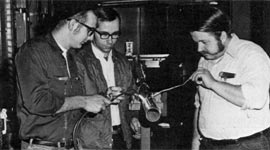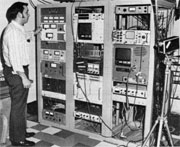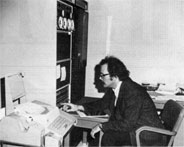Main Ring group preparing for first NAL experiment
The excitement of the final stages of bringing the NAL accelerator into operation was almost equaled by the suspense of waiting to start the first experiment on the machine. And NAL had a group of men working on both fascinating aspects of high energy physics at the same time.
The group included Ernie Malamud, Ryuji Yamada, Dick Carrigan, Bruce Strauss, Jim Klen, and a group of NAL technicians. They were part of a larger group preparing Experiment Number 36, titled, "Small Angle Proton-Proton Scattering," which included men from three other institutions - Rockefeller University, New York City; the University of Rochester, Rochester, N. Y.; and the Joint Institute for Nuclear Research in Dubna. Experiment 36 was the first to be performed at NAL.
The first phase of the experiment employed a tiny rotating "target" of polyethylene film .0001 inches thick. The target was installed just under the beam pipe in the tunnel below Service Building C-0. It was lifted into the beam line by an electric motor when beam became available to the experimenters.
A vacuum can slantsed up at an angle from the target installation to several small counters in the C-0 building corridor. The slant angle was chosen so that the maintenance crew's golf carts could pass freely under the vacuum chamber without the riders having to duck their heads. The results that occurred when the target was struck by the Main Ring proton beam were gathered on a computer in the building above and then measured, studied, and evaluated.
Proton-proton scattering was considered a "simple" experiment. The process is somewhat analogous to a "billiard ball collision." The original proton strikes the target and scatters in a manner quite similar to a grazing collision of two billiard balls. One proton recoils almost perpendicular to the beam line just as the target billiard ball does. The characteristics of the proton (the ball) become clearer; the angles and distribution of the recoils give clues to the shape of the proton. One of the prime advantages of using the Main Ring was that the experiment could be carried out as the machine accelerated and data taken at all energies during a single machine pulse.
Physicists Malamud and Yamada were assigned to the NAL Accelerator Section. Both were deeply involved for many months in the design, construction and commissioning of the accelerator. Their work in the Main Ring led to their interest in the possibility of utilizing it directly for experiments. Their expertise brought to the experimental group the distinct advantage of knowing the temperament of the giant machine, for they both spent many hours at the Main Ring control console in the course of bringing the machine into operation.
Strauss, a metallurgist, was also a cryogenic specialist and familiar with engineering problems in the Main Ring. Jim Klen and the technicians brought installation know-how to the effort, having lived with the vacuum system of the Main Ring since construction began.
When the NAL group changed hats and moved from construction headquarters to the Experiment 36 location, they went to Service Building C-0 on the Main Ring Road. There they joined Steve Olson, a physicist from Rockefeller who had been on site since June of 1971, working on construction of the experimental equipment, I Hung Chiang, physicist, and Dan Gross, graduate student, both from Rochester. Chiang and Gross planned and built the electronic equipment that was part of the experimental apparatus.
The second phase of Experiment 36 substituted a hydrogen gas jet for the foil target. Equipment for this phase was installed in the beam line just ahead of the foil target. The results obtained when the proton beam struck the gas jet was studied by the group. But this activity involved much more complicated equipment. 'To keep the gas from seeping into the Main Ring vacuum chambers after it performed its function as a target, it was frozen by allowing it to strike a helium-coated plate at the base of the apparatus. The frozen gas became a solid "chunk of ice" which at intervals was raised out of the apparatus and recycled. The second phase of Experiment 36 was carried out with the Dubna collaborators who pioneered this technique.
Thus, the NAL Main Ring was the stage on which a major physics drama was played. The exhilaration of watching the new machine operate and the satisfaction of providing for the first experiment on it provided the plot and the action.







